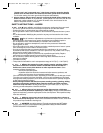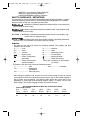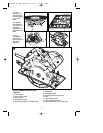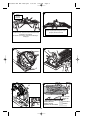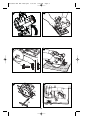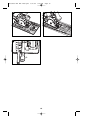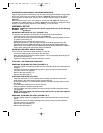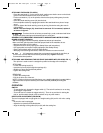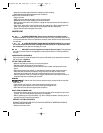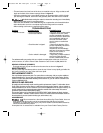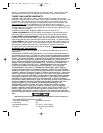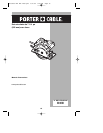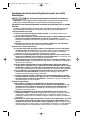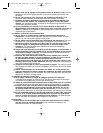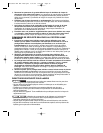
13
• Keep the kerf plate aligned with the cutting line while sawing.
• Work with the shoe pressed against the workpiece.
ADJUSTING THE KERF PLATE
• Plug in the saw.
• Make a test cut halfway through a piece of scrap wood.
• Withdraw the saw so the cutting line becomes visible.
• While keeping the saw in this position, unplug the saw and loosen the kerf plate on
the saw shoe.
• Align the 0° mark (22) on the kerf plate with the cutting line. When adjusting for 45°
miter cuts, align the 45° mark (23) on the kerf plate with the cutting line.
• Secure the kerf plate using the screw (24).
LASER LINE
LASER RADIATION. Never aim the beam at a workpiece with a
reflective surface. Bright shiny reflective sheet steel or similar reflective surfaces are
not recommended for laser use. Reflective surfaces could direct the beam back toward
the operator.
LASER RADIATION. AVOID DIRECT EYE EXPOSURE. Do not stare
into the laser light source. Never aim light at another person or object other than
the workpiece. Laser light can damage your eyes.
DO NOT use tinted glasses to enhance the laser light. Tinted glasses
will reduce overall vision for the application and interfere with the normal operation of
the tool.
LASER SWITCH (FIGURE N)
To turn the laser on, push forward on the laser on/off switch (2) to activate the laser line
(25) as shown in figure N.
TO USE THE LASER LINE
• Mark the line that you intend to cut on the workpiece.
• Adjust the depth and angle of cut as required.
• Push the laser on/off switch (2) to the forward “ON” position and project the laser
beam.
• Depress the saw trigger switch (1) and allow the blade to reach maximum speed.
• Place the saw shoe on the workpiece. Align the laser line with the mark on the
workpiece and slowly push the saw forward keeping the laser line on the mark.
• Upon completion of the cut, release the trigger and allow the saw blade to come to a
complete stop before switching off the laser.
SAWING
To reduce the risk of serious personal injury, always hold the tool with
both hands.
• Let the blade run freely for a few seconds before starting the cut.
• Apply only a gentle pressure to the tool while performing the cut.
• Work with the shoe pressed against the workpiece.
HINTS FOR OPTIMUM USE
• As some splintering along the line of cut on the top side of the workpiece cannot be
avoided, cut on the side where splintering is acceptable.
• Where splintering is to be minimized, e.g. when cutting laminates, clamp a piece of
plywood onto the top of the workpiece.
POCKET CUTTING (FIGURE O)
POCKET CUTTING IS USED TO CUT AHOLE IN A PIECE OF MATERIAL WITHOUT
CUTTING FROM THE SIDE.
• Measure and mark work.
:
:
:
:
90539190 REV MAY 2009.qxd 5/27/09 9:22 AM Page 13



